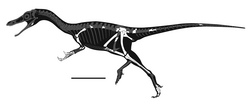| Shishugounykus Temporal range: Late Jurassic, ~ | |
|---|---|
 | |
| Skeletal reconstruction | |
| Scientific classification | |
| Kingdom: | Animalia |
| Phylum: | Chordata |
| Class: | Reptilia |
| Clade: | Dinosauria |
| Clade: | Saurischia |
| Clade: | Theropoda |
| Superfamily: | † Alvarezsauroidea |
| Genus: | † Shishugounykus Qin et al., 2019 |
| Type species | |
| †Shishugounykus inexpectus Qin et al., 2019 | |
Shishugounykus (meaning "Shishugou claw") is a genus of basal alvarezsaurian dinosaur from the Shishugou Formation of Xinjiang, China. The type and only species is Shishugounykus inexpectus. The specific name refers to the unexpected discovery of another species of alvarezsaur from the Shishugou Formation (other alvarezsaurs from this formation include Haplocheirus and possibly Aorun ). [1] Its affinities to alvarezsaurs have subsequently been questioned. [2]









